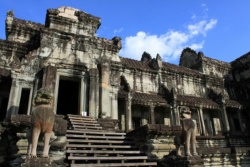History of Madhyamika
The Sanskrit word "Madhyamika" means "one who holds to the middle". The concept of "The Middle Way" in Buddhism begins with the Buddha's description of his path to enlightenment as one that avoids the extremes of indulging in worldly pleasures, on the one hand, and engaging in severe ascetic practices on the other. The Middle Way of Madhyamika refers to the teachings of Nagarjuna, who, at a time when the Mahayana (Great Vehicle) teachings were falling into decline, wrote his Six Treatises, four of which directly expound the doctrine of sunyata, or emptiness.
Emptiness refers to the ultimate nature of all things. It is the key concept in this physics. One who correctly understands emptiness is described as free from the extremes of existence and annihilation. To fall to the extreme of existence is to hold that, in the final analysis, phenomena truly exist. To fall to the extreme of annihilation is to hold that phenomena don't have any kind of existence at all. According to the theory of emptiness, phenomena exist in a relative state only, a kind of 'ontological relativity'. The term used to describe this mode of existence is "dependent arising", which term describes how it is that something which is empty of true existence can have any sort of existence - only in relation to, or dependent on, something else. Phenomena are regarded as dependent, transient events, rather than things that have their own inherent nature; thus the extreme of permanence is avoided. By the same token, dependent existence is something more than none, and so annihilation is avoided. These doctrines of emptiness and dependent arising are central to all schools of Madhyamika.
The works of Nagarjuna and his immediate follower Aryadeva are considered the basis of interpretation and understanding by later Madhyamikas. There is much that the two "Model Text" Madhyamikas did not directly establish, however, and in the centuries after their passing (the dates are disputed Ð Nagarjuna for instance is held by his tradition to have lived for 800 years, leading western scholars to posit as many as three separate Nagarjunas, but the texts seem to date to the first few centuries A.D./ Common Era) the loopholes were exploited by various scholars interested in establishing their notions on these open subjects as the highest interpretation. There are many ways in which the different interpretations were and are divided into "schools of thought" or "tenet systems", etc. In India, the scholars seem to have been content to argue their positions without concerning themselves about labeling their systems. When Buddhism began to spread into Tibet, however, the effort to organize and delineate the arguments led to various systems of classification.
During the early propagation of Buddhism in Tibet (c. 650-850 CE), one way of classifying the schools of Madhyamika was by the position held regarding certain aspects of ultimate truth, a method the great master Je Tsongkapa (2) later described as deluded. (3) As all who followed him seem to have agreed on this point, we will pass over its details. Using one's position on the conventional (as opposed to ultimate) status of external objects as a criterion was helpful, in that it classified schools of Madhyamika in a way that reflected the source school of these positions. Here, the system of Bhavaviveka, which attributed conventional existence to external objects, was called Sautrantika-Madhyamika, and the system of Santaraksita, which denied conventional existence to externals, was aptly named Yogacara-Madhyamika. This situation was nevertheless deficient because it failed to include the position of Candrakirti, a later Indian scholar who made even more subtle distinctions on the nature of external objects.
This scholastic process, along with nearly all Buddhist activity in Tibet, was interrupted for a few centuries by the collapse of the Tibetan Empire in the 9th century and the persecution of Buddhism by proponents of the earlier Bon religion. With the beginning of the "later propagation" of Buddhism in the 11th century came the distinction of systems that stands today, that of the Svatantrikas and the Prasangikas. The basis for this division was a loophole in Nagarjuna's writings; how the understanding of emptiness is to be produced in the mind of an opponent. (4)
The fundamental goal of Buddhism is to dispel the ignorance that keeps all sentient beings trapped in the cycle of birth, death and re-birth or "Samsara". This ignorance is the lack of understanding of emptiness. To inquire what the various schools mean by "emptiness" is to open the can of worms, for their definitions are contingent upon which scriptures are held to be the word of the Buddha, and within that limit, which scriptures are definitive and which are interpretable. The major split of Hinayana and Mahayana derives from the first distinction, and as all Madhyamika schools are within the Mahayana branch they accept the same canon, which subsumes the Hinayana canon. It is inevitable that within such a huge body of information one will find many assertions that seem to contradict other statements. The explanation for this is that when the Buddha lectured he would speak to the level of understanding of his audience, at times teaching doctrines that were not ultimately correct but which would prod the understanding of his audience along in the right direction. It is said that those not prepared to understand or accept emptiness should not be taught it, lest they develop adverse reactions and so more harm be done than good. Both Prasangika and Svatantrika accept that sutras that teach ultimate truth, or emptiness, are definitive, while those that do not are interpretable. Exploiting yet another loophole, the Svatantrikas make the further distinction that a sutra must also be "literally acceptable".
A few more historical points are in order before discussing the differences between these schools of thought. It should be stressed that the Prasangika view is considered the highest interpretation of Nagarjuna's Middle Way in modern Tibetan philosophy. Since the time of Tsongkapa, the Svatantrika way of understanding Madhyamika has been taught as a system to be refuted. However, the Svatantrika that is being refuted may not be identical to the originally intended system of the Svatantrika founders. It is said that heresy is merely the side that loses the fight for orthodoxy, and in a country like Tibet, where monasteries were often caught up in the political struggles of the times, it is possible that some doctrines were abandoned on grounds other than logical inconsistency. This is not to say that the subtle differences between Svatantrika and Prasangika were the cause of violent conflicts, as one sees so often in the history of early Christian disputes over Christ's physical composition. Rather, it might be more accurate to say that the positions held by Tibetan orders were, like the monasteries themselves, susceptible to the fortunes of the wars that their feudal (as well as Mongol) benefactors engaged in.
It is also important to note that the Indian scholars who are credited with founding the branches of Madhyamika, the so-called Partisan Madhyamikas, did not recognize themselves as Svatantrikas or Prasangikas, and only Candrakirti among them recognized their subtle divergences on the meaning of emptiness. (5) As they developed in Tibet, the fortunes of Svatantrika and Prasangika through the Middle Ages reflected, to some extent, the Tibetan political environment of the times. The Svatantrika texts may not have been as thoroughly or fairly examined as they might by the generations of Tibetan scholars after Tsongkapa, who firmly established that the highest interpretation is found in Prasangika. This means that Svatantrika has not had truly committed proponents to champion its cause for many centuries. The Svatantrika found in the arguments of the Prasangikas, then, can only be described as Prasangikan Svatantrika. To determine the extent of the Prasangika distortion of Svatantrika would require a separate effort, so with the above qualifications in mind, we will get on with sorting out Madhyamika as we have it.


